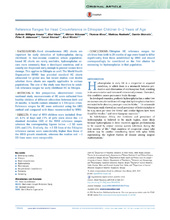| dc.contributor.author | Amare, Ephrem Bililigne | en_US |
| dc.contributor.author | Idsøe, Mari | en_US |
| dc.contributor.author | Wiksnes, Miriam | en_US |
| dc.contributor.author | Moss, Thomas | en_US |
| dc.contributor.author | Roelants, Mathieu | en_US |
| dc.contributor.author | Shimelis, Damte | en_US |
| dc.contributor.author | Juliusson, Petur Benedikt | en_US |
| dc.contributor.author | Kiserud, Torvid | en_US |
| dc.contributor.author | Wester, Knut | en_US |
| dc.date.accessioned | 2016-04-05T15:19:57Z | |
| dc.date.available | 2016-04-05T15:19:57Z | |
| dc.date.issued | 2015-12 | |
| dc.Published | World Neurosurgery 2015, 84(6):1566-1571 | eng |
| dc.identifier.issn | 1878-8769 | |
| dc.identifier.uri | https://hdl.handle.net/1956/11857 | |
| dc.description.abstract | BACKGROUND: Head circumference (HC) charts are important for early detection of hydrocephalus during childhood. In low-income countries where populationbased HC charts are rarely available, hydrocephalus occurs more commonly than in developed countries, and is usually not diagnosed early enough to prevent severe brain damage. This applies to Ethiopia as well. The World Health Organization (WHO) has provided standard HC charts advocated for global use, but recent studies cast doubts whether these charts are equally applicable in various populations. The aim of the study was therefore to establish reference ranges for early childhood HC in Ethiopia. METHODS: In this prospective, observational crosssectional study, measurements of HC were collected from healthy children of different ethnicities between birth and 24 months, in health centers situated in 5 Ethiopian cities. Reference ranges for HC were estimated using the LMS method and compared with those recommended by WHO. RESULTS: A total of 4019 children were included. Overall, 6.7% of boys and 7.1% of girls were above the D2 standard deviation (SD) of the WHO reference ranges, whereas the corresponding figures below L2 SD were 2.8% and 2.1%. Similarly, the D2 SD lines of the Ethiopian reference curves were considerably higher than those of the WHO growth standards, whereas the median and L2 SD lines were more comparable. CONCLUSIONS: Ethiopian HC reference ranges for children from birth to 24 months of age were found to differ significantly from those established by WHO and should correspondingly be considered as the first choice for screening for hydrocephalus in that population. | en_US |
| dc.language.iso | eng | eng |
| dc.publisher | Elsevier | eng |
| dc.rights | Attribution CC BY-NC-ND | eng |
| dc.rights.uri | http://creativecommons.org/licenses/by-nc-nd/4.0/ | eng |
| dc.subject | Developing country | eng |
| dc.subject | Ethiopia | eng |
| dc.subject | Head circumference | eng |
| dc.subject | Hydrocephalus | eng |
| dc.subject | Neurosurgery | eng |
| dc.subject | Occipitofrontal circumference | eng |
| dc.subject | Pediatrics | eng |
| dc.subject | Screening | eng |
| dc.title | Reference ranges for head circumference in ethiopian children 0-2 years of age | en_US |
| dc.type | Peer reviewed | |
| dc.type | Journal article | |
| dc.date.updated | 2016-02-04T13:16:02Z | |
| dc.description.version | publishedVersion | en_US |
| dc.rights.holder | Copyright 2015 the authors | |
| dc.identifier.doi | https://doi.org/10.1016/j.wneu.2015.08.045 | |
| dc.identifier.cristin | 1322893 | |

